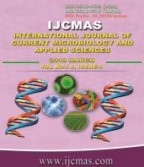


 National Academy of Agricultural Sciences (NAAS)
National Academy of Agricultural Sciences (NAAS)

|
PRINT ISSN : 2319-7692
Online ISSN : 2319-7706 Issues : 12 per year Publisher : Excellent Publishers Email : editorijcmas@gmail.com / submit@ijcmas.com Editor-in-chief: Dr.M.Prakash Index Copernicus ICV 2018: 95.39 NAAS RATING 2020: 5.38 |
Sorghum shoot fly [Atherigona soccata (Rondani)] is one of the most important pests of grain sorghum. It is important to understand the nature of gene action to breed for resistance to the target insect pest. In the present study, a population of 259 sorghum recombinant inbred lines (RILs) derived from cross 296B (shoot fly susceptible) x IS 18551 (shoot fly resistant) were evaluated in shoot fly screening nursery to study the inheritance of shoot fly resistance. Variances due to RIL genotypes (G), screening environment (E) and G x E interactions were significant for the traits studied. Normal distribution of RIL means suggested quantitative inheritance of trait studied. Heritability (broad sense) estimates for glossiness intensity, oviposition incidence (%) and dead hearts incidence (%) were consistent in individual and low across environment analyses indicating that, these traits can be used as reliable parameters to select a plant with resistance to shoot fly. High broad sense heritability estimates were recorded for trichome densities (on both upper and lower leaf blades), but exhibited significant G x E interactions. Transgressive sergeants with phenotypic values outside the parental limits were observed for oviposition (%), dead heart (%) and trichome density. Utilization of RILs 46, 208, 222 and 223 (kharif season adaptation) and RILs 47, 51, 82, 97, 130 and 174 (rabi season adaptation) which exhibited shoot fly resistance combined with better agronomic feature will be useful in sorghum shoot fly resistance breeding.
 |
 |
 |
 |
 |